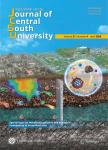Preparation and antimicrobial ability of natural porous antibacterial materials
Preparation and antimicrobial ability of natural porous antibacterial materials作者机构:School of Materials Science and Engineering Southwest University of Science and Technology Mianyang 621010 China School
出 版 物:《Journal of Central South University of Technology》 (中南工业大学学报(英文版))
年 卷 期:2005年第12卷第4期
页 面:370-375页
核心收录:
学科分类:08[工学] 080501[工学-材料物理与化学] 0805[工学-材料科学与工程(可授工学、理学学位)]
基 金:Project(40072020)supportedbytheNationalNaturalScienceFoundationofChina project(2001AA322070)supportedbytheNationalHighTechnologyResearchandDevelopmentProgramofChina
主 题:liquid ion exchange solid salt melt dry-wet circulation mineral antimicrobial material
摘 要:The liquid ion exchange method, solid salt melt method and dry-wet circulation method were used to prepare natural porous antimicrobial materials with natural minerals, such as zeolite, spilite, palygorskite and montmorillonite, respectively. Atomic absorption spectrum and X-ray diffraction analysis were carried out to investigate the effects of Ag^+ , Cu^2+ and Zn^2+ on antimicrobial abilities of natural porous minerals, and the effect of preparation method on ion exchange capacity of antimicrobial material, respectively. The results show that for the ion exchange capacity, clay mineral is higher than fibrous mineral, i.e. both zeolite and montmorillonite are higher; the antimicrobial ability of material with Ag^+ is the bests the exchange capacities of materials with Cu^2+ or Zn^2+ are all higher, but the antimicrobial ability of Cu^2+ is better than that of Zn^2+ .



